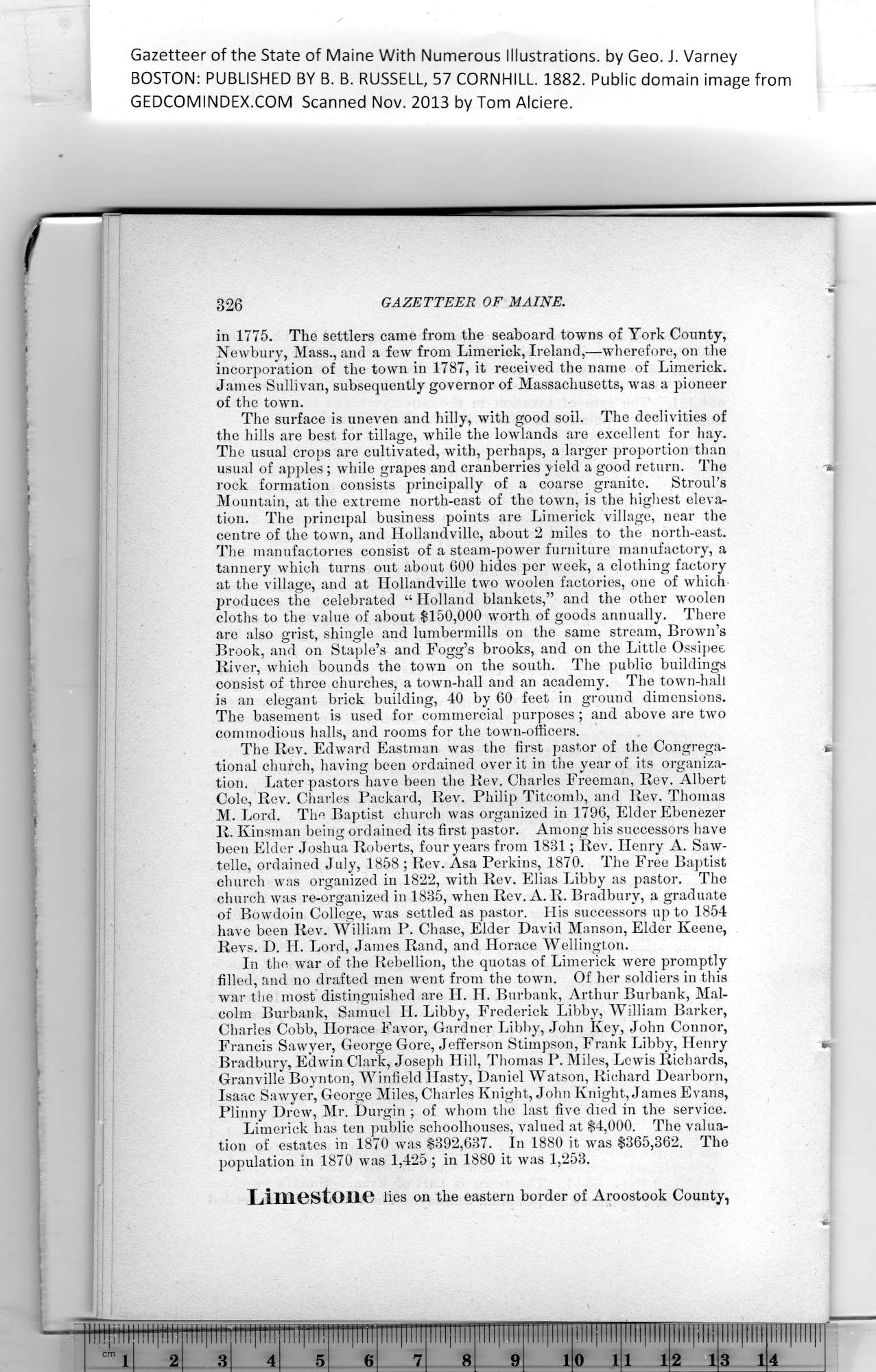|
Gazetteer of the State of Maine With Numerous Illustrations, by Geo. J. Varney
BOSTON: PUBLISHED BY B. B. RUSSELL, 57 CORNHILL. 1882. Public domain image from
326 GAZETTEER OF MAINE.
in 1775. The settlers came from the seaboard towns of York County,
Newbury, Mass., and a few from Limerick, Ireland,—wherefore, on the
incorporation of the town in 1787, it received the name of Limerick.
James Sullivan, subsequently governor of Massachusetts, was a pioneer
of the town.
The surface is uneven and hilly, writh good soil. The declivities of
the hills are best for tillage, while the lowlands are excellent for hay.
The usual crops are cultivated, with, perhaps, a larger proportion than
nsual of apples; while grapes and cranberries yield a good return. The n,
rock formation consists principally of a coarse granite. StrouTs
Mountain, at the extreme north-east of the towm, is the highest eleva-
tion. The principal business points are Limerick village, near the
centre of the town, and Hollandville, about 2 miles to the north-east.
The manufactories consist of a steam-power furniture manufactory, a
tannery which turns out about 600 hides per week, a clothing factory
at the village, and at ITollandville two woolen factories, one of which
produces the celebrated “Holland blankets,” and the other woolen
cloths to the value of about $150,000 worth of goods annually. There
are also grist, shingle and lumbermills on the same stream, Brown’s
Brook, and on Staple’s and Fogg’s brooks, and on the Little Ossipee
River, which bounds the town on the south. The public buildings
consist of three churches, a town-hall and an academy. The town-hall
is an elegant brick building, 40 by 60 feet in ground dimensions.
The basement is used for commercial purposes ; and above are two
commodious halls, and rooms for the town-ofiicers.
The Rev. Edward Eastman was the first pastor of the Congrega- *
tional church, having been ordained over it in the year of its organiza-
tion. Later pastors have been the Rev. Charles Freeman, Rev. Albert
Cole, Rev. Charles Packard, Rev. Philip Titcomb, and Rev. Thomas
M. Lord. The Baptist church was organized in 1796, Elder Ebenezer
R. Kinsman being ordained its first pastor. Among his successors have
been Elder Joshua Roberts, four years from 1831; Rev. Henry A. Saw-
telle, ordained July, 1858 ; Rev. Asa Perkins, 1870. The Free Baptist
church was organized in 1822, with Rev. Elias Libby as pastor. The
church was re-organized in 1835, when Rev. A. R. Bradbury, a graduate
of Bowdoin College, was settled as pastor. His successors up to 1854
have been Rev. William P. Chase, Elder David Manson, Elder Keene,
Revs. D. H. Lord, James Rand, and Horace Wellington.
In the war of the Rebellion, the quotas of Limerick were promptly
filled, and no drafted men went from the town. Of her soldiers in this
war the most distinguished are H. H. Burbank, Arthur Burbank, Mal-
colm Burbank, Samuel H. Libby, Frederick Libby, William Barker,
Charles Cobb, Horace Favor, Gardner Libby, John Key, John Connor,
Francis Sawyer, George Gore, Jefferson Stimpson, Frank Libby, Henry »
Bradbury, Edwin Clark, Joseph Hill, Thomas P. Miles, Lewis Richards,
Granville Boynton, Winfield Hasty, Daniel Watson, Richard Dearborn,
Isaac Sawyer, George Miles, Charles Knight, John Knight, James Evans,
Plinuy Drew, Mr. Durgin ; of whom the last five died in the service.
Limerick has ten public schoolhouses, valued at $4,000. The valua-
tion of estates in 1870 was $392,637. In 1880 it was $365,362. The
population in 1870 was 1,425 ; in 1880 it was 1,253.
Limestone lies on the eastern border of Aroostook County,
PREVIOUS PAGE ... NEXT PAGE
This page was written in HTML using a program written in Python 3.2
|
